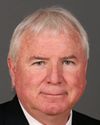Of course the priority is decided by the clinic staff upon their analysis of the condition of the client, so it's not first arriving, first in. The wait time that we're trying to achieve within the clinics is to have 80% of the initial interviews with the patient or client within 15 working days. We have a phone contact, so it will be faster if we're told by the referring organization that this client really is in need.
The way we deal with the issue of capacity is that the 2007 budget allowed us to open five new clinics, so it's going to double our capacity across the country. In each of the clinics, if there's a need, we will increase the capacity of the clinic by funding the province with new resources.




